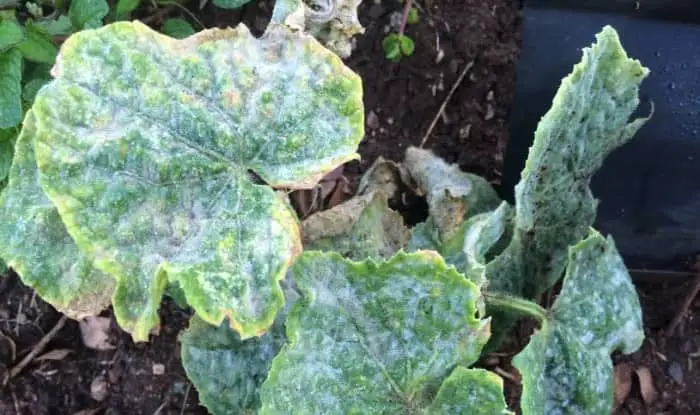Cucumber leaves turning white is a common problem for vegetable gardeners.
But fortunately, it’s easy to identify and do something about.
Disease, pests, and inadequate growing conditions are usually responsible.
So in this article, we’ll take a closer look at the causes, how you can identify them on your cucumber plant, and what you can do to prevent and treat the problem.
Cucumber Leaves Turning White: The Causes
There are 6 common causes of cucumber leaves turning white: powdery mildew, septoria leaf spot, leafhopper infestation, iron deficiency, sunscald, and transplant shock.
It’s important to recognize the problem quickly so you can take the appropriate action. A quick response will often prevent the loss of leaves and save the plant from further harm, as it may die if left.
Powdery Mildew
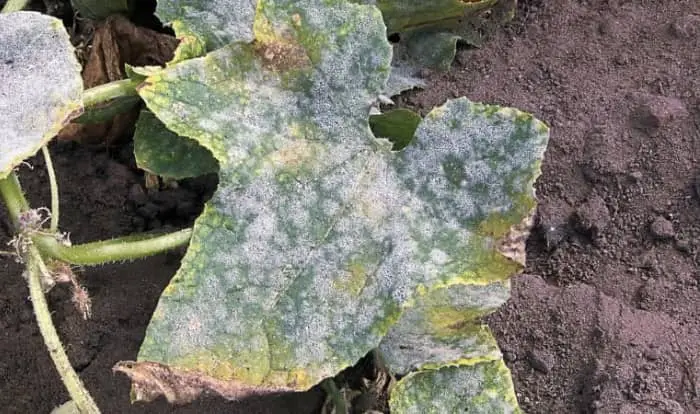
Photo by Rasbak, CC BY-SA 3.0
Powdery mildew is a common fungal infection that affects plants. In the case of cucumbers and other cucurbits such as squash and zucchini, the main fungus responsible is called Podosphaera xanthii (1).
The telltale signs are powdery white spots that grow on both the upper and lower sides of the leaves. They rapidly expand into larger patches, and often cover a large percentage of the leaf surface. Spores can also appear on the fruit and stems of the plant.
You’ll often see infected white leaves wilting in the heat. And if the disease progresses, you’ll see the cucumber leaves starting to turn brown, drying up, curling, and eventually falling off.
If you leave it until most of the foliage is infected, then the plant becomes weakened, with premature ripening of fruit that’s often under-sized and malformed.
As it spreads, you might also see cucumbers turning white as the fungus starts to grow on the fruit.
Treatment
The good news is that it’s not fatal for the plant if you detect it early. They can recover.
Natural fungicides such as neem oil can be useful to treat plants when you first notice them developing a white coating.
And if the infection is mild or moderate, then you can use a horticultural oil such as Sunspray Ultra-Fine Spray Oil or Saf-T-Side Spray Oil to eradicate the infection.
But be careful not to use oil-based sprays when temperatures get over 90°F or on plants with drought stress.
Prevention
If you know that the area you’re planting in is susceptible to powdery mildew then prevention is the best strategy (2).
Sulfur-based fungicides are a good choice. They should be applied to both sides of the cucumber plant’s leaves every 7-10 days while the conditions for powdery mildew growth persist.
You can also use baking powder as a homemade remedy. It’s ineffective on its own, but when you combine it with liquid soap and water it works as a preventative.
Add 1 tablespoon of baking soda and a half teaspoon of non-detergent soap to a gallon of water. Mix them together to make a spray and make sure your cucumber plants are well covered.
With a bit of planning and care, you can also remove the conditions that give rise to the problem.
Powdery mildew tends to thrive in places that receive a low amount of sunlight, with moderate temperatures. So try to place your plants in a location where they’ll get 6 hours or more of sunlight per day.
It’s also a good idea to space your plants out, allowing good air circulation around them, taking care to stake the plants around 3ft apart, and practicing regular weed control.
Another thing to try is removing excess foliage. This allows sunlight to get through to the lower leaves, which are susceptible to developing powdery mildew if they’re left in the shade.
Choosing cucumber varieties that are mildew-resistant is recommended if you’re planting in an area where powdery mildew has occurred before.
Popular choices include Eureka, Jackson Supreme, Sweet Success, and Straight Eight.
Septoria Leaf Spot
Septoria leaf spot is a fungal disease that infects cucurbits, including cucumber plants. To begin with, it appears on the leaves as dark, wet spots but turns to beige or white as the disease progresses (3).
If you notice septoria leaf spot growing on your cucumber leaves, treat them with a fungicide as soon as possible. The fungus spreads from plant to plant by water and can infect all your plants if you leave it to grow.
Fungal spores survive in the ground for a year or more, so be careful about planting in the soil where infected plants have been and destroy any plant debris you remove from affected plants.
Leaving space between your cucumber plants can prevent the spread of septoria leaf spot, as can irrigation at the base rather than from above, and rotating your cucumber plants with other non-cucurbit plants in your garden every two years.
Leafhoppers
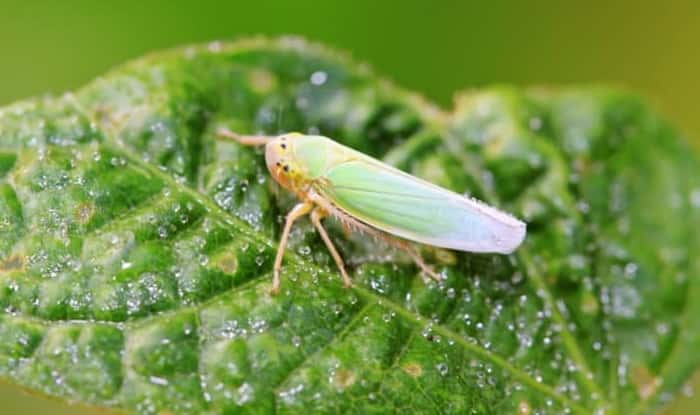
There are many insects that pose a threat to cucumber plants. But the leafhopper is the most likely culprit for turning leaves white.
They feed on the underside of the leaves. Sucking out the inner contents, leading to discoloration of the leaf. In doing so, their toxic saliva causes visible white specks.
Leafhoppers are easy to identify. The adults are about 1/4 of an inch long and are quick to fly away if disturbed. Slender and wedge-shaped, they come in brown, yellow, or green, with markings.
Once you know that they’re causing the cucumber leaf issues, how do you stop them?
Try floating row covers to prevent them from getting at the plants.
And thoroughly covering the upper and lower surfaces of the leaves with insecticidal soap can get rid of an infestation.
Remember to clean up garden debris after harvest to minimize the number of locations they can use to over-winter.
Iron Chlorosis
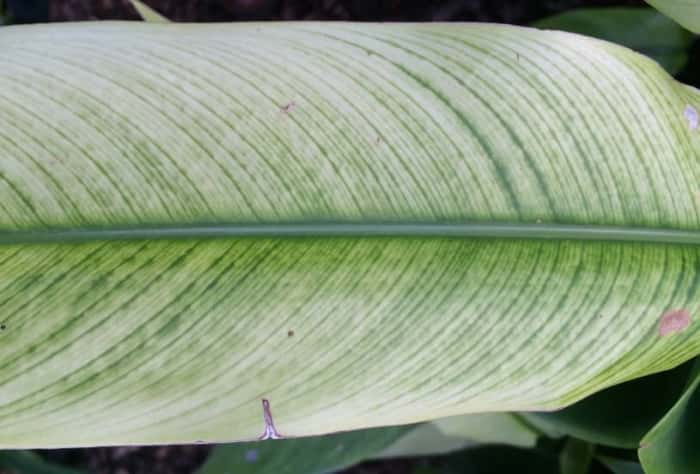
Chlorosis of bird of paradise leaf
Iron chlorosis is the loss of color in plant leaves due to nitrogen deficiency. To begin with, the cucumber leaves lose color, turning yellow.
Eventually, as the deficiency becomes severe, you’ll see the pale cucumber leaves turning white. With the outer edges starting to look scorched and brown as the leaf starts to die.
The dark green veins are highly visible against this loss of color and will help you easily identify the problem.
Applying iron chelates to the soil can help as a treatment and prevent your plant from dying. As can foliar sprays that contain chelated iron or ferrous sulfate.
Sunscald
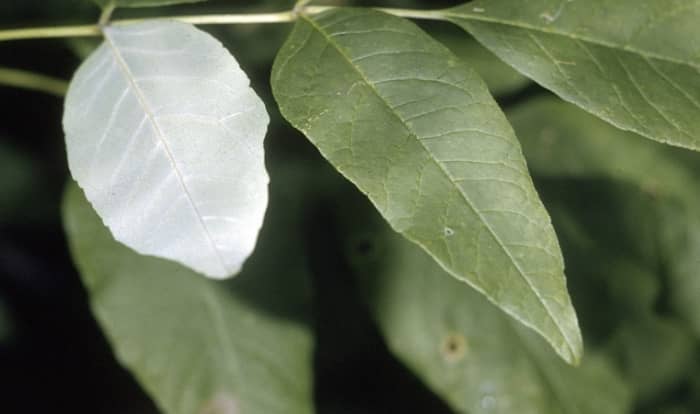
Sunscald on the leaf of Fraxinus americana Robert H. Mohlenbrock. Courtesy of USDA NRCS Wetland Science Institute., Public domain, via Wikimedia Commons
Too much exposure to direct sunlight can cause sunscald on cucumber plant leaves.
Minor cases will see the leaves turn pale and blister. But the affected leaves increasingly appear white with further sun exposure and will eventually die and fall off.
Cucumber seedlings and young plants are particularly susceptible to sunscald after transplant as they move from indoor conditions to outdoor or greenhouse conditions.
To prevent it, remember to give your plants slower exposure to direct sunlight, a process known as hardening off. Try using a sunshade to protect them from sunburn for a couple of weeks until they toughen up.
Transplant Shock
The change in conditions after outside planting or damage to the roots during transplantation can cause cucumber plants to wilt and the leaves to turn white.
Plants adjusting to the new climate can recover and regain their green color. If the root system is badly damaged, the plant will die.
FAQ
Can cucumber plants recover from powdery mildew?
While cucumber plants can recover from powdery mildew to some extent, it largely depends on the severity of the infection and the measures taken to manage the disease. If the infection is mild and caught early, it’s possible for the plants to recover with appropriate treatment and care. However, if the infection is severe and widespread, recovery is hard.
Here are some steps you can take to help cucumber plants recover from powdery mildew:
Prune the infected parts
Remove heavily infected leaves, stems, and fruits. This helps prevent the spread of the disease to healthier parts of the plant.
Improve air circulation
Ensure proper spacing between plants to allow for good air circulation, as powdery mildew thrives in humid and crowded conditions. This helps reduce moisture on the foliage and slows down the spread of the fungus.
Water at the base
Avoid overhead watering, which can promote the growth and spread of powdery mildew. Instead, water the plants at the base, keeping the foliage as dry as possible.
Provide sunlight
Position the plants in a location with ample sunlight. Direct sunlight helps inhibit the growth of powdery mildew.
Apply fungicides
If the infection is severe, you may need to use fungicides labeled for powdery mildew control. Follow the instructions carefully and apply as directed.
It’s worth noting that prevention is often the best approach for managing powdery mildew. Planting disease-resistant cucumber varieties and practicing good cultural practices from the beginning can help minimize the risk of infection and reduce the need for extensive recovery efforts.
Is powdery mildew harmful to cucumbers?
Yes, powdery mildew can be harmful to cucumbers. Powdery mildew is a fungal disease caused by various species of the fungus Podosphaera xanthii or Erysiphe cichoracearum. It manifests as a white or gray powdery coating on the leaves, stems, and sometimes fruits of plants.
The growth and overall health of cucumber plants infected by powdery mildew are negatively affected. The fungus interferes with photosynthesis, reducing the plant’s ability to produce energy and nutrients, leading to stunted growth, decreased fruit production, and eventually plant death if the infection becomes severe.
In addition to the direct damage to cucumber plants, powdery mildew can also impact the quality and marketability of the fruits. The affected cucumbers may develop blemishes, discoloration, or become distorted in shape.
It’s necessary to practice good cultural practices such as providing adequate air circulation, avoiding overhead watering, and removing infected plant parts to prevent infection and the spread of this fungus. There are also fungicides available that you can use to control the disease if necessary.
References:
- Powdery Mildew Of Cucurbits – https://extension.umn.edu/diseases/powdery-mildew-cucurbits
- Powdery Mildew On Vegetables – http://ipm.ucanr.edu/PMG/PESTNOTES/pn7406.html
- Cucumber – https://plantvillage.psu.edu/topics/cucumber/infos
